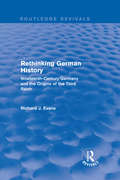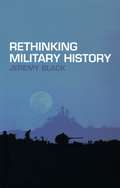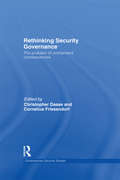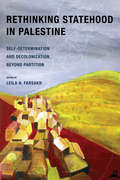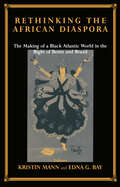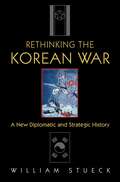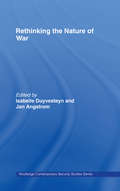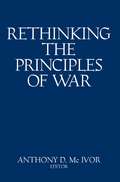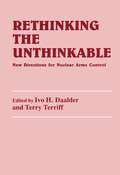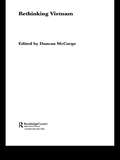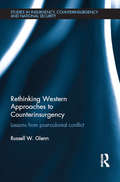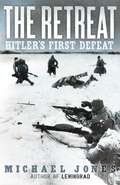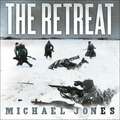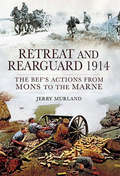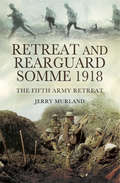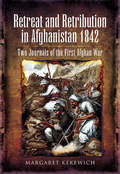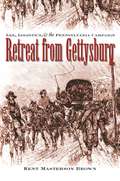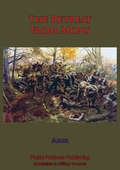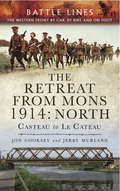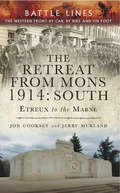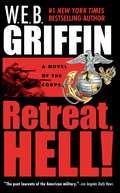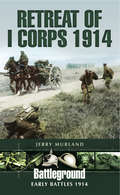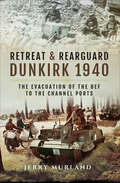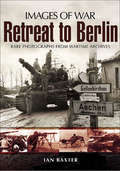- Table View
- List View
Rethinking German History: Nineteenth-Century Germany and the Origins of the Third Reich (Routledge Revivals)
by Richard J. EvansIn Rethinking German History, first published in 1987, Richard J. Evans argues for a social-historical approach to the German past that pays equal attention to objective social structures and subjective values and experiences. If German history has been seen as an exception to the ‘normal’ development of Western society, this is not least because historians have until recently largely failed to look beyond the world of high politics, institutions, organizations and ideologies to broader historical problems of German society and German mentalities. By applying and adapting approaches learned from French and British social history as they have been developed over the last quarter of a century, it is possible to achieve a rethinking of German history which does away with many of the textbook myths that have encrusted the historiogrpahy of Germany for so long. This book will be valuable for students of German history and politics, and brings together essays widely used in teaching. Its broad coverage of social history will also be useful to all those interested in contemporary historiography or the comparative study of European history.
Rethinking Military History
by Jeremy BlackRethinking Military History is a bold new 'thought book' that reconsiders military history at the beginning of the twenty-first century. The chapters provide a valuable and concise survey of the main themes in the study of military history from 1500 to the present day as Jeremy Black reveals the main trends in the practice and approach to mili
Rethinking Security Governance: The Problem of Unintended Consequences (Contemporary Security Studies)
by Christopher DaaseThis book explores the unintended consequences of security governance actions and explores how their effects can be limited. Security governance describes new modes of security policy that differ from traditional approaches to national and international security. While traditional security policy used to be the exclusive domain of states and aimed at military defense, security governance is performed by multiple actors and is intended to create a global environment of security for states, social groups, and individuals. By pooling the strength and expertise of states, international organizations, and private actors, security governance is seen to provide more effective and efficient means to cope with today’s security risks. Generally, security governance is assumed to be a good thing, and the most appropriate way of coping with contemporary security problems. This assumption has led scholars to neglect an important phenomenon: unintended consequences. While unintended consequences do not need to be negative, often they are. The CIA term "blowback," for example, refers to the phenomenon that a long nurtured group may turn against its sponsor. The rise of al Qaeda, which had benefited from US Cold War policies, is only one example. Raising awareness about unwanted and even paradoxical policy outcomes and suggesting ways of avoiding damage or limiting their scale, this book will be of much interest to students of security governance, risk management, international security and IR. Christopher Daase is Professor at the Goethe University Frankfurt and head of the research department International Organizations and International Law at the Peace Research Institute Frankfurt (PRIF/HSFK). Cornelius Friesendorf is lecturer at the Goethe University Frankfurt and research fellow at the Peace Research Institute Frankfurt (PRIF/HSFK).
Rethinking Statehood in Palestine: Self-Determination and Decolonization Beyond Partition (New Directions in Palestinian Studies #4)
by Leila H. FarsakhA free open access ebook is available upon publication. Learn more at www.luminosoa.org. The quest for an inclusive and independent state has been at the center of the Palestinian national struggle for a very long time. This book critically explores the meaning of Palestinian statehood and the challenges that face alternative models to it. Giving prominence to a young set of diverse Palestinian scholars, this groundbreaking book shows how notions of citizenship, sovereignty, and nationhood are being rethought within the broader context of decolonization. Bringing forth critical and multifaceted engagements with what modern Palestinian self-determination entails, Rethinking Statehood sets the terms of debate for the future of Palestine beyond partition.
Rethinking the African Diaspora: The Making of a Black Atlantic World in the Bight of Benin and Brazil
by Kristin Mann Edna G. BayAs a result of new research, we can now paint a more complex picture of peoples and cultures in the south Atlantic, from the earliest period of the slave trade up to the present. The nine papers in this volume indicate that a dynamic and continuous movement of peoples east as well as west across the Atlantic forged diverse and vibrant re-inventions and re-interpretations of the rich mix of cultures represented by Africans and peoples of African descent on both continents.
Rethinking the History of Italian Fascism (Routledge Studies in Modern European History)
by Giulia AlbaneseIn the last years, the discussion around what is fascism, if this concept can be applied to present forms of politics and if its seeds are still present today, became central in the political debate. This discussion led to a vast reconsideration of the meaning and the experience of fascism in Europe and is changing the ways in which scholars of different generations look at this political ideology and come back to it and it is also changing the ways in which we consider the experience of Italian fascism in the European and global context. The aim of the book is building a general history of Fascism and its historiography through the analysis of 13 different fundamental aspects, which were at the core of Fascist project or of Fascist practices during the regime. Each essay considers a specific and meaningful aspect of the history of Italian fascism, reflecting on it from the vantage point of a case study. The essays thus reinterrogates the history of Fascism to understand in which way Fascism was able to mould the historical context in which it was born, how and if it transformed political, cultural, social elements that were already present in Italy. The themes considered are violence, empire, war, politics, economy, religion, culture, but also antifascism and the impact of Fascism abroad, especially in the Twenties and at the beginnings of the Thirties. The book could be both used for a general public interested in the history of Europe in the interwar period and for an academic and scholarly public, since the essays aim to develop a provocative reflection on their own area of research.
Rethinking the Korean War: A New Diplomatic and Strategic History
by William StueckFought on what to Westerners was a remote peninsula in northeast Asia, the Korean War was a defining moment of the Cold War. It militarized a conflict that previously had been largely political and economic. And it solidified a series of divisions--of Korea into North and South, of Germany and Europe into East and West, and of China into the mainland and Taiwan--which were to persist for at least two generations. Two of these divisions continue to the present, marking two of the most dangerous political hotspots in the post-Cold War world. The Korean War grew out of the Cold War, it exacerbated the Cold War, and its impact transcended the Cold War. William Stueck presents a fresh analysis of the Korean War's major diplomatic and strategic issues. Drawing on a cache of newly available information from archives in the United States, China, and the former Soviet Union, he provides an interpretive synthesis for scholars and general readers alike. Beginning with the decision to divide Korea in 1945, he analyzes first the origins and then the course of the conflict. He takes into account the balance between the international and internal factors that led to the war and examines the difficulty in containing and eventually ending the fighting. This discussion covers the progression toward Chinese intervention as well as factors that both prolonged the war and prevented it from expanding beyond Korea. Stueck goes on to address the impact of the war on Korean-American relations and evaluates the performance and durability of an American political culture confronting a challenge from authoritarianism abroad. Stueck's crisp yet in-depth analysis combines insightful treatment of past events with a suggestive appraisal of their significance for present and future.
Rethinking the Nature of War (Contemporary Security Studies)
by Isabelle Duyvesteyn Jan AngstromHave globalization, virulent ethnic differences, and globally operating insurgents fundamentally changed the nature of war in the last decade? Interpretations of war as driven by politics and state rationale, formulated most importantly by the 19th century practitioner Carl von Clausewitz, have received strong criticism. Political explanations have been said to fall short in explaining conflicts in the Balkans, Africa, Asia and the attacks of 11 September 2001 in the United States.This book re-evaluates these criticisms not only by scrutinising Clausewitz's arguments and their applicability, but also by a careful reading of the criticism itself. In doing so, it presents empirical evidence on the basis of several case studies, addressing various aspects of modern war, such as the actors, conduct and purposes of war.
Rethinking the Principles of War
by Anthony D. McivorThis new work features the fresh thinking of twenty-eight leading authors from a variety of military and national security disciplines. Following an introduction by Lt. Gen. James Dubik, Commander I Corps, U.S. Army, and an opening essay titled "State of the Question" by Dr. Colin Gray, the anthology first considers the general question of "An American Way of War?" Sections on operational art, with writers addressing the issues in both conventional and small wars; stability and reconstruction; and intelligence complete the volume. Among the well-known contributors are Fred Kagan, Ralph Peters, Harlan Ullman, and Milan Vego. This collection of essays is the outcome of a seminar series sponsored by the Office of Force Transformation and the U.S. Navy to examine the future of warfare and the underlying principles of war and to educate future military strategists and leaders on these principles. Footnotes, index, and a bibliographic essay make the work a useful tool for students of war and general readers alike.
Rethinking the Unthinkable: New Directions for Nuclear Arms Control
by Ivo H. Daalder Terry TerriffRethinking the Unthinkable examines the future direction of nuclear arms control in the post-Cold War security environment. Believing that the new environment requires a radical rethinking of the purpose and role of nuclear weapons in international politics, the contributors address many fundamental issues influencing further US, Russian and European nuclear arms reductions. This volume is a product of the Project on Rethinking Arms Control, sponsored by the Center for International and Security Studies in Maryland.
Rethinking Vietnam (Rethinking Southeast Asia)
by Duncan McCargoA uniquely comprehensive overview of a fascinating and rapidly changing country, dealing with the politics, economics, society and foreign policy of Vietnam from the Doi Moi reforms of market socialism in 1986 to the present day. Drawing on fieldwork and analysis by an international team of specialists this book covers all aspects of contemporary Vietnam including recent history, the political economy, the reform process, education, health, labour market, foreign direct investment and foreign policy. The contributors show how the blurring of old and new pressures and traditions within Vietnam requires a more complex analysis of the country than might initially be assumed.
Rethinking Western Approaches to Counterinsurgency: Lessons From Post-Colonial Conflict (Studies in Insurgency, Counterinsurgency and National Security)
by Russell W. GlennThis book critically examines the Western approach to counter-insurgency in the post-colonial era and offers a series of recommendations to address current shortfalls. The author argues that current approaches to countering insurgency rely too heavily on conflicts from the post-World War II years of waning colonialism. Campaigns conducted over half a century ago – Malaya, Aden, and Kenya among them – remain primary sources on which the United States, British, Australian, and other militaries build their guidance for dealing with insurgent threats, this though both the character of those threats and the conflict environment are significantly different than was the case in those earlier years. This book addresses the resulting inconsistencies by offering insights, analysis, and recommendations drawn from campaigns more applicable to counter-insurgency today. Eight post-colonial conflicts; to include Northern Ireland, Sierra Leone, Colombia and Iraq; provide the basis for analysis. All are examples in which counterinsurgents attained or continue to demonstrate considerable progress when taking on enterprises better known for disaster and disappointment. Recommendations resulting from these analyses challenge entrenched beliefs to serve as the impetus for essential change. Rethinking Western Approaches to Counterinsurgency will be of much interest to students of counter-insurgencies, military and strategic studies, security studies and IR in general.
The Retreat: The Retreat
by Michael JonesAt the moment of crisis in 1941 on the Eastern front, with the forces of Hitler massing on the outskirts of Moscow, the miraculous occurred: Moscow was saved. Yet this turning point was followed by a long retreat, in which Russian forces, inspired by old beliefs in the sacred motherland, pushed back German forces steeled by the vision of the ubermensch, the iron-willed fighter. Many of Russia's 27 million military and civilian deaths occurred in this desperate struggle.In THE RETREAT, Michael Jones, acclaimed author of LENINGRAD, draws upon a mass of new eye-witness testimony from both sides of the conflict to tell, with matchless vividness and comprehensiveness, of the crucial turning point of the Second World War - the moment when the armies of Hitler could go no further - and of the titanic and cruel struggle of two mighty empires.
The Retreat: Hitler's First Defeat
by Michael JonesThe thrilling history of the turning point of the Second World War, when Hitler's armies were halted on the Eastern FrontAt the moment of crisis in 1941 on the Eastern front, with the forces of Hitler massing on the outskirts of Moscow, the miraculous occurred: Moscow was saved. Yet this turning point was followed by a long retreat, in which Russian forces, inspired by old beliefs in the sacred motherland, pushed back German forces steeled by the vision of the ubermensch, the iron-willed fighter. Many of Russia's 27 million military and civilian deaths occurred in this desperate struggle.In THE RETREAT, Michael Jones, acclaimed author of LENINGRAD, draws upon a mass of new eye-witness testimony from both sides of the conflict to tell, with matchless vividness and comprehensiveness, of the crucial turning point of the Second World War - the moment when the armies of Hitler could go no further - and of the titanic and cruel struggle of two mighty empires.(P)2018 Hodder & Stoughton Limited
Retreat and Rearguard, 1914: The BEF's Actions From Mons to the Marne
by Jerry MurlandThe British action at Mons on 23 August 1914 was the catalyst for what became a full blown retreat over 200 blood drenched miles. This book examines eighteen of the desperate rearguard actions that occurred during the twelve days of this near rout. While those at Le Cateau and Nery are well chronicled, others such as cavalry actions at Morsain and Taillefontaine, the Connaught Rangers at Le Grand Fayt and 13 Brigades fight at Crepy-en-Valois are virtually unknown even to expert historians. We learn how in the chaos and confusion that inevitably reigned units of Gunners and other supporting arms found themselves in the front line.The work of the Royal Engineers responsible for blowing bridges over rivers and canals behind the retreating troops comes in for particular attention and praise. Likewise that of the RAMC. No less than 16 VCs were won during this historic Retreat, showing that even in the darkest hours individuals and units performed with gallantry, resourcefulness and great forbearance.The book comes alive with first hand accounts, letters, diaries, official unit records, much of which has never been published before.
Retreat and Rearguard, Somme 1918: The Fifth Army Retreat
by Jerry MurlandThe German Spring offensive or Kaiserschlacht was a period of great danger for the Allies. Both sides were exhausted after years of bitter fighting and huge losses. While eventually catastrophically unsuccessful and the prelude to their final defeat, the Germans forced the Allies back over hard-won ground until the tide turned.Historian Jerry Murland has researched and visited the scenes of desperate actions during late March 1918. He describes in graphic detail the battles fought by British, Irish and South African regiments in the area from St Leger in the North to La Fere in the South. He unearths the extraordinary stories of unit and individual courage. He also examines the work of the Royal Engineers who blew bridges and disrupted lines of communication. This original approach covers battles that in many cases have only been described briefly in official histories. The book is a useful companion for any battlefield visitor.
Retreat and Retribution in Afghanistan 1842: Two Journals of the First Afghan War
by Margaret KekewichThe blow to British pride and confidence caused by the crushing defeat of their army in Afghanistan during the winter of 1841/2 compares in its impact to the disaster in New York on 11 September 2001. The British had replaced a popular and effective monarch with a weak one in the mistaken belief that he would keep the Russians at bay. Two years later, nearly all the British and Indian soldiers in the region were killed in a popular uprising.Margaret Kekewichs perceptive new study of the conflict describes the British defeat, their reoccupation of Afghanistan in the spring of 1842, then their final withdrawal at the end of the year. Her account, which is based on the graphic diaries written by two British eyewitnesses, gives a fascinating insight into the conflict in Afghanistan 150 years ago.The story is told by, first, Lady Sale who together with over 100 women, children and soldiers was captured and imprisoned by the Afghans. The second account comes from the Reverend Allen, a young chaplain to the army that invaded Afghanistan in April 1842 to avenge British humiliation and rescue the prisoners. Both these eyewitnesses deplored the follies that had led to war and defeat and also the suffering that was inflicted on many innocent Afghans.At a time when British forces are deeply engaged in another war in Afghanistan, Margaret Kekewich offers a balanced and thought-provoking new perspective on a previous conflict in the region.
Retreat from Gettysburg
by Kent Masterson BrownIn a groundbreaking, comprehensive history of the Army of Northern Virginia's retreat from Gettysburg in July 1863, Kent Masterson Brown draws on previously untapped sources to chronicle the massive effort of General Robert E. Lee and his command as they sought to move people, equipment, and scavenged supplies through hostile territory and plan the army's next moves. Brown reveals that even though the battle of Gettysburg was a defeat for the Army of Northern Virginia, Lee's successful retreat maintained the balance of power in the eastern theater and left his army with enough forage, stores, and fresh meat to ensure its continued existence as an effective force.
The Retreat From Mons
by Anon.The Retreat From Mons, or 'The Great Retreat', was a harsh lesson for both the British troops who were retreating in the face of the overwhelming forces of the German Armies, and the Germans themselves, with the stubborn tenacity and fighting abilities of the long-service British Tommies. The action in this volume begins with the mobilization of the British Expeditionary Force, to the beginning of the battle of the Marne. The book was officially endorsed and benefits from a foreword by Field Marshal French who was in command of the British Expeditionary Force at the time.
The Retreat from Mons 1914: Casteau to Le Cateau (Battle Lines: The Western Front By Car, By Bike and On Foot)
by Jon Cooksey Jerry MurlandMons to the Marne, the latest volume in Pen & Sword's Battle Lines series of walking, cycling and driving guides to the Western Front, is the essential companion for every visitor who is keen to retrace the path taken by the British Expeditionary Force immediately after the outbreak of the First World War. All the most famous battle sites of the Great Retreat are featured here. Expert guides Jon Cooksey and Jerry Murland take visitors over a series of routes that can be walked or biked or driven, explaining the fighting that occurred in each place in vivid detail. They describe what happened, where it happened, and why, and who was involved, and point out the sights that remain there for the visitor to see. Their highly illustrated guidebook is essential reading for visitors who wish enhance their understanding of the fast-moving campaign that preceded the war in the trenches. It gives a fascinating insight into the experience of the troops, the terrain over which they fought and the character of fighting itself.As featured in the Stratford-upon-Avon Herald.
The Retreat from Mons 1914: Etreux to the Marne (Battle Lines: The Western Front By Car, By Bike and On Foot)
by Jon Cooksey Jerry MurlandThe Retreat from Mons 1914: South is the second volume in Pen & Sword's Battle Lines series to cover the opening campaign of the Great War. It is the essential companion for every visitor who is keen to retrace the path taken by the British Expeditionary Force immediately after the outbreak of the conflict all the important battle sites of the second stage of the retreat are featured here. Expert guides Jon Cooksey and Jerry Murland take visitors over a series of routes that can be walked, biked or driven, explaining the fighting that occurred at each place in vivid detail. They describe what happened, where it happened and why and who was involved, and point out the sights that remain for the visitor to see.Their highly illustrated guidebook is essential reading for visitors who wish to enhance their understanding of the fast-moving campaign that preceded the war in the trenches. It gives a fascinating insight into the experience of the troops, the terrain over which they fought and the character of the fighting itself.
Retreat, Hell!: Book Ten In The Corps Series (Corps #10)
by W.E.B. GriffinIt is the fall of 1950. The Marines have made a pivotal breakthrough at Inchon, but a roller coaster awaits them. <P><P>The bit in his teeth, Douglas MacArthur is intent on surging across the 38th parallel toward the Yalu River, where he is certain no Chinese are waiting for him, while Major Ken McCoy, operating undercover, hears a different story entirely, and is just as intent on nailing down the truth before it is too late. Meanwhile, Brigadier General Fleming Pickering, shuttling between two continents, works desperately to mediate the escalating battle between MacArthur and President Harry Truman, while trying to keep his mind from the cold fact that somewhere out there, his own daredevil pilot son, Pick, is lost behind enemy lines - and may be lost forever. Before Retreat, Hell! is finished, all their fates will be determined - and for some of them, it will be a bitter pill indeed.
Retreat of I Corps 1914: Early Battles 1914 (Battleground Ser.)
by Jerry MurlandOn 23 August 1914 it was only the two divisions of General Smith-Dorrien's II Corps that were directly engaged with the German First Army along the line of the Mons-Conde Canal. As the British Expeditionary Force withdrew from Mons and bivouacked around Bavay on 25 August, Sir John French and his GHQ advisors unsure of the condition of the routes through the Fort de Mormal - ordered the British Expeditionary Force to continue their retirement the next day and to avoid the 35 square miles of forest roads.Consequently II Corps used the roads to the west of the Fort de Mormal and Sir Douglas Haig's I Corps those to the east with the intention that the four divisions should meet again at Le Cateau. It was an intention that was ambushed by circumstance as I Corps encountered units of the German 7th Division at Landrecies on 25/26 August. Unsure of the weight of the German attack at Landrecies, Douglas Haig hurriedly left for Grand Fayt and ordered his two divisions to immediately begin their retirement along a route that would take them west of Le Cateau. It was this decision that kept the by now five divisions of the BEF apart until 1 September and is the subject of this book. I Corps was now coming under attack from the German Second Army and the resulting rearguard actions that Haig's men were involved in are covered in this volume:
Retreat & Rearguard: The Evacuation of the BEF to the Channel Ports
by Jerry MurlandThe dramatic story of how a quarter million men were evacuated from the coast of France—and how the British Expeditionary Force fought on. This book, part of the Retreat and Rearguard series, covers the actions of the BEF during the retreat from the Dyle Line to the evacuation points of Dunkirk, Boulogne, Calais, Saint-Valery-en-Caux, and finally the Cherbourg Peninsula. Some of the engagements are relatively well known (Cassell, the Arras counter-attack, and the notorious Le Paradis SS massacre), but the author has unearthed many less known engagements from the long and painful withdrawal. While the main Dunkirk evacuation from the port and beaches was over by early June, elements of the BEF fought on until June 21. In relating those often heroic actions, this book catches the atmosphere of desperate defiance that typified this never-to-be-forgotten period.
Retreat to Berlin: Rare Photographs from Wartime Archives (Images of War)
by Ian BaxterDrawing on a superb collection of rare and unpublished photographs this latest book in the popular Images of War Series provides an absorbing insight into the last desperate year of the German Army. It analyses, in dramatic detail, the German retreat from the wastelands of the Eastern and Western Fronts into a bombed and devastated Third Reich to the very gates of Berlin.Accompanied by detailed captions and text, the book shows how Wehrmacht, Waffen-SS, Luftwaffe, Hitlerjugend and Volksturm personnel attempted to defend every yard of ground against the overwhelming Allied forces. As the final months of the war are played out the reader learns how the Germans fought to the death in a desperate attempt to prevent what Hitler called the two fold devastation of the Reich. Despite the adverse situation in which the German Army was placed, soldiers continued right to the very end, holding their lines under the constant hammer blows of ground and air bombardments. Those German forces that were fortunate enough to survive the overwhelming ferocity of the enemy onslaught, gradually streamed back to fight on home soil until they were either destroyed or were driven around a devastated Berlin.
